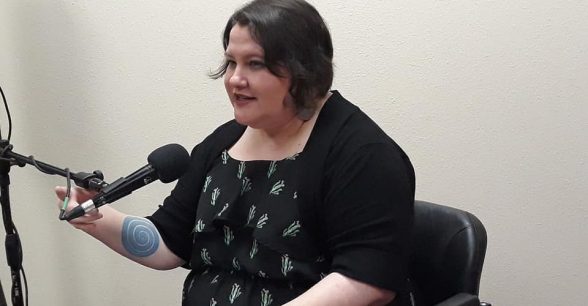Very Unfair: The Nightmare of Institutionalization
Like so much in this dystopia, care is about money. And disability is most certainly expensive. The durable medical equipment, medication, personal care, transportation, home modifications—the shopping list goes on. And everything tagged “accessible” is marked way up. Until I became disabled myself, I didn’t understand the extent to which ableism permeates people’s lives, including our wallets.
These aren’t expenses that the average individual can afford, so most of us find ourselves relying on state and federal government programs: for the care we need, supplies we use, and often the very roof over our head (if we have one). Those social safety nets don’t do a fantastic job of catching us, though. Most often we live in poverty, the care we need frequently compromised.
So, with the crushing of my C4 vertebra, I punched my pass to the ableist world that limits me even more than the blatant refusal of my central nervous system to send memos to my limbs. Financially broke and broken, I found myself dumped into a long-term care system that could be described the same way: broken. Yet any U.S. resident can find themselves in this dysfunctional system in an instant, upon becoming disabled—as I did, the passenger in a car accident—and where millions end up simply by aging.
My domestic options as a 32-year-old, blue collar single mom suddenly rendered a quadriplegic were: a skilled nursing facility, an assisted living home, or attempting to survive on my own on disability checks and the mere 40 hours of personal care assistance that Medicaid provided at home. I managed to stay out of institutions for the first five years, though at times it was a nightmare.
Living independently wasn’t an option because, having no use of my hands, I couldn’t be alone for more than a few hours. I also couldn’t afford rent on my own anymore; the waiting list I was on for affordable, accessible housing was years-long.
I lived instead with family, but that meant they couldn’t work outside of the home because they had to stay with me. Through Medicaid’s self-directed care plan, I could hire family members to do the maximum hours of care that Medicaid allowed. We used the meager checks to pay rent. But with no outside help, my family burned out from my care needs quickly. Our relationships suffered tremendously.
Personal care attendants were hard to find, which was understandable because the work is demanding and pays very poorly. I couldn’t afford to pay out of pocket and the companies that Medicaid approves don’t pay much.
Finally, I moved into a facility.
Compromised Care in Facilities
Living in an institution strips an individual of an incredible amount of autonomy. Our daily schedule becomes dependent on the schedule of the care home. Private rooms are only provided if medical need can be proven or if you pay out of pocket, but most of us are on Medicaid. Social security and disability checks are surrendered to help Medicaid pay for our room and care. In addition, we’re only allowed to keep a “personal needs” allowance of about $100 per month. Surrendering my house full of furniture and familiarity to a storage unit to move into half a bedroom and kissing my daughter and pets goodbye knowing that I’d only see them on visits felt very unfair.
I know that the cost of my care is much greater than the amount of money I put into social security as a hard working welder during my short, able-bodied adult life. But even if I’d never worked to pay into the system at all, is institutionalization fair to anyone?
If you’ve ever been inside a nursing home, you know how clinical, depressing, and isolating the atmosphere is. Assisted living homes are often no better, characterized by the same isolation. Facility life could be less dehumanizing if the care in these homes wasn’t so compromised.
I quickly realized that the first home I lived in was intentionally understaffed by inexperienced workers, to maximize the profits of the owners who lived in one of the wealthiest homes in my small, rural community. The contract I’d signed claimed that the home offered 24/7 care. However, caregivers often didn’t sleep in staggered shifts, which meant that they were usually unreachable at night, all resting at the same time. The food budget was so low that residents snuck in food at night; they never bought any fresh vegetables or fruit.
Medication errors sent a roommate to the hospital, where she died. On multiple occasions, I experienced autonomic dysreflexia. This is an issue experienced by people with paralysis that’s characterized by dangerous hypertension or other symptoms. And it only happened because my needs weren’t met on time, my bladder often too full.
The caregivers were often temporary, live-in employees without proper caregiver certifications and training. Many were exploited undocumented immigrants. Some confided in me that management had instructed them to identify themselves with false credentials should the state come for an inspection. Others told me that management had given them permission to ignore our calls for help.
The second assisted living home where I lived was a much different experience. The numerous state violations I’d become accustomed to at the previous institution didn’t occur here. Unfortunately, when I relocated to the city a year later, I found myself in yet another facility where nearly every possible corner was cut. Upon further research, I realized just how typical that abysmal standard of care is in the U.S.
From directors of nursing denying my essential passive-range-of-motion physical therapy with the shocking assertion that my body is “deteriorating anyway” to management hanging up when I reported dangerous caregiver negligence, the truth is that these institutions aren’t operated with quality of care or human dignity in mind.
Within them, I’ve been forgotten.
What Needs to Change?
- Advocate for home-based services. Institutions have a monopoly on the long-term care industry, but they’re never the first choice for people who are elderly and/or disabled. We need care performed in the comfort of our own homes, even if the need is 24/7.
- Demand higher wages for direct care workers, including those paid by the state. Both in residential and institutional settings, caregivers are exploited by insulting wages.
- Overhaul required training and certification regulation and transparency. We must also end unfair understaffing practices that result in compromised care behind closed doors.
- Advocate for those you love in the long-term care system. If you know someone in an institution, check on them and make sure they know how to advocate for their rights. There are agencies focused on protecting the rights of people with disabilities nationwide.
I’m hoping to live independently when I finish grad school and start a new career. I’ll be able to afford rent—and hopefully the personal care attendant hours I need which Medicaid won’t cover. I’ll have to be careful though because, if I make too much, I’ll lose Medicaid and have to pay for all my care out of pocket. I’m pretty sure they don’t pay Arizona teachers enough to cover all of that!
I might escape the institutions, but many people with disabilities may never be able to hold a job. Does that mean these institutions are sufficient though? Should anyone be denied the dignity of living in their own home and receiving the care they need in that setting?
It’s often been said that the measure of a society can be found in how it treats its most vulnerable. In the years that I’ve spent trying to survive in the long-term care system, it’s become my opinion that our country is failing miserably.
About Rooted In Rights
Rooted in Rights exists to amplify the perspectives of the disability community. Blog posts and storyteller videos that we publish and content we re-share on social media do not necessarily reflect the opinions or values of Rooted in Rights nor indicate an endorsement of a program or service by Rooted in Rights. We respect and aim to reflect the diversity of opinions and experiences of the disability community. Rooted in Rights seeks to highlight discussions, not direct them. Learn more about Rooted In Rights



